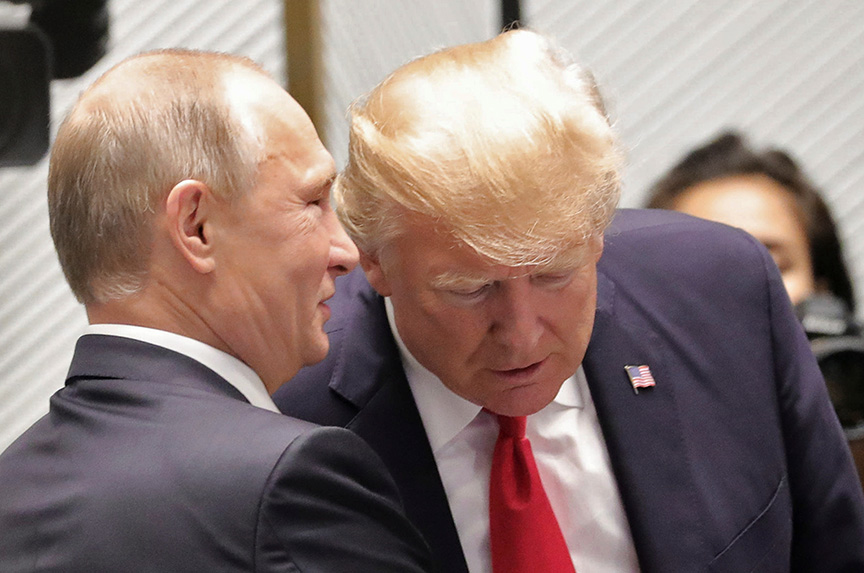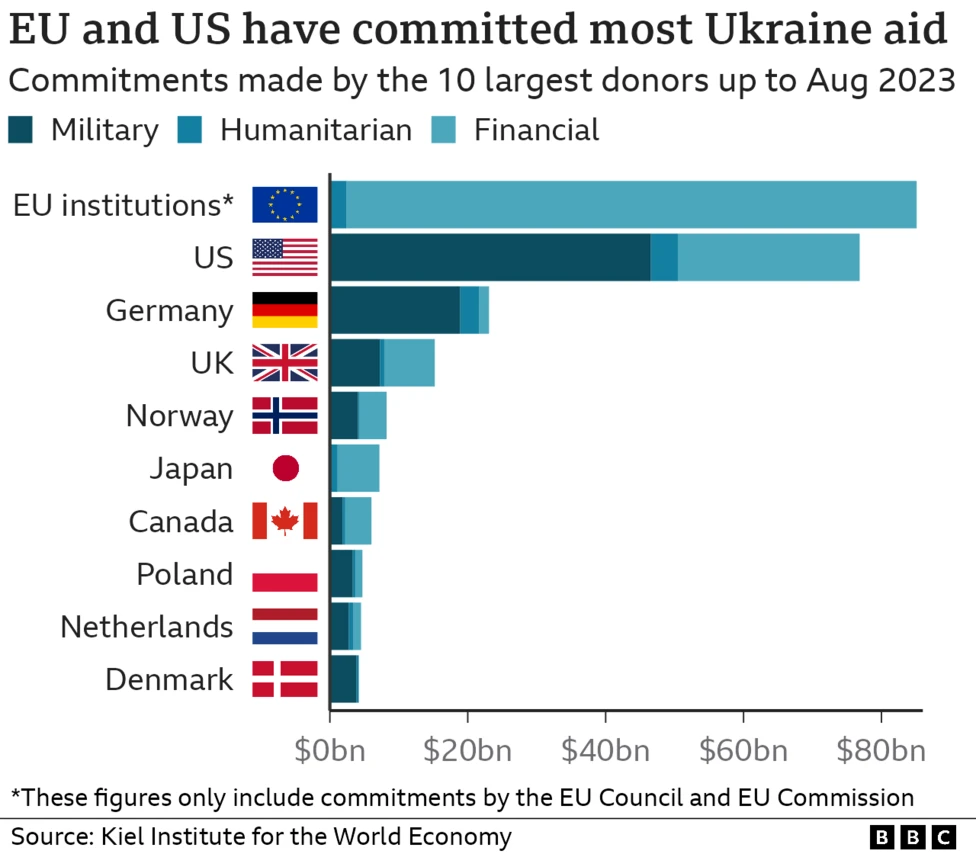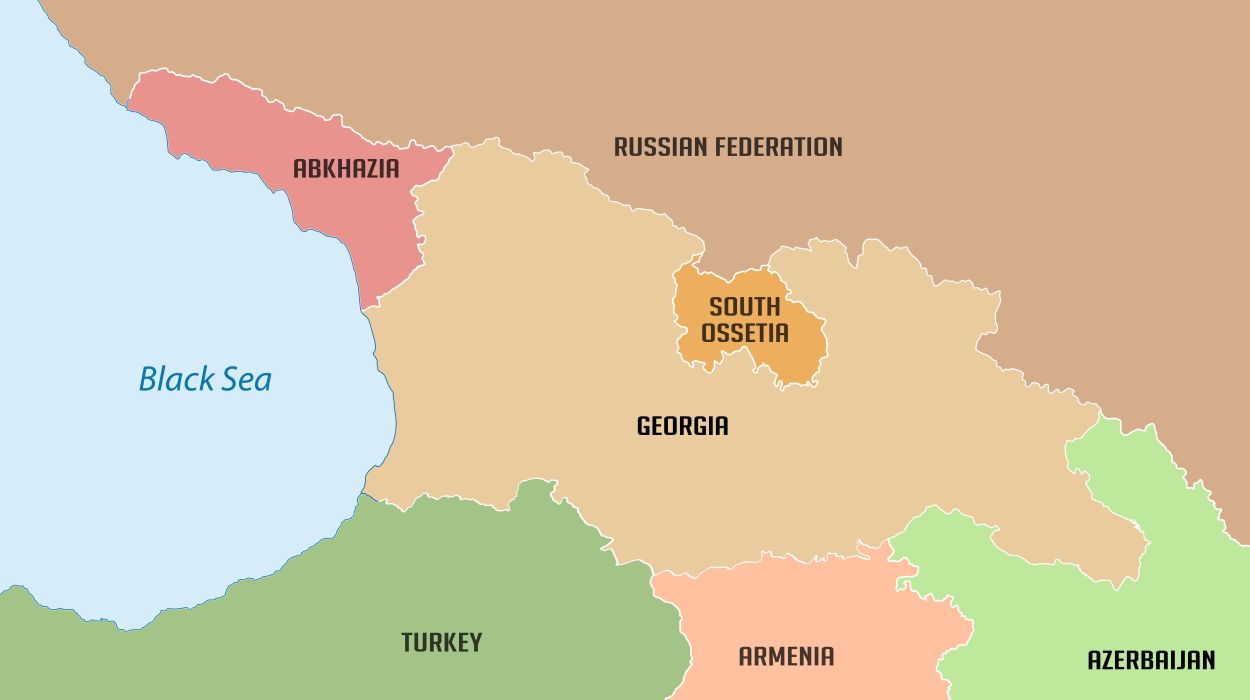Trump, Putin, and the Fate of Ukraine: A Geopolitical Gamble - Opinion

The key figures driving Ukraine’s path to resolution or escalation.
Opinion – Editorial
The ongoing war in Ukraine stands at a critical juncture, with potential resolutions hinging on high-stakes diplomacy and shifting global alliances. As the conflict reshapes international power dynamics, key players such as the United States, Russia, and Europe grapple with strategies to secure their interests. This article examines the intricate interplay of political manoeuvres, economic pressures, and the broader implications for regional stability, offering a detailed analysis of what the future may hold for Ukraine and the world.
Will the War in Ukraine End This Year?
All hopes are pinned on the prospect of the war in Ukraine concluding in 2025. Why is there such optimism? A key factor sustaining the conflict has been the United States' support for Ukraine. The US has provided over $100 billion in military equipment, ammunition, and other aid. Without this assistance, Russia would likely have occupied the entirety of Ukraine by now.
During his campaign, Donald Trump declared that he could end this war within 24 hours, or at most, a few days. Meanwhile, in the almost three months since Trump won the election, the trajectory of the war has intensified rather than de-escalated. This escalation can partly be attributed to a policy inherited from former President Joe Biden, who authorised Ukraine to utilise US-supplied long-range missiles to strike Russian targets. At the same time, Russia has actively worked to strengthen its position on the ground. Additionally, Ukraine has intensified its attacks in the Kursk region, leveraging it as a bargaining chip in negotiations.
Last week, Trump officially assumed the presidency, and among the first to congratulate him was Vladimir Putin. Putin expressed hope that Trump’s tenure in Washington would swiftly lead to friendlier relations between the United States and Russia, even suggesting that Trump's leadership could help avert a potential World War III.
In a press conference, Trump mentioned the likelihood of meeting Putin in the near future. This meeting, expected to take place soon, carries significant implications. While it raises hopes for peace, it is already clear that any peace deal would likely come at a substantial cost to Ukraine.
Thus far, Trump has successfully persuaded Ukraine, a task that may have been the easiest part. Heavily dependent on American arms for its defence, Ukraine would find its options severely constrained should this aid be withdrawn.
Whether Ukraine—and its allies—agree to relinquish its occupied territories to Russia temporarily or permanently remains to be seen. However, one thing is certain: they have come to terms with the fact that nothing will return to the way it was. The disputed territories include four major provinces in eastern Ukraine as well as Crimea, although it is worth noting that Crimea is no longer a subject of negotiation. Whether Russia would be content with Donbas and its surrounding areas alone remains uncertain.
Ahead of any negotiations, Trump is likely to work on strengthening his hand. Unlike many leaders, Trump approaches international relations with the mindset of a businessman. At times, he also adopts a more combative stance, using the threat of sanctions to pressure the opposing side into compliance.
Trump’s Approach to Russia: A Businessman’s Gambit

In a statement directed at Russia, Trump urged, 'End this ridiculous war in Ukraine. Otherwise, new sanctions, tariffs, and taxes will follow.' He further asserted that his efforts to resolve the conflict were 'a tremendous favour to Russia and its president,' adding, 'Russia’s economy is on the brink of collapse, and I am doing Putin a great service.' Despite this tough rhetoric, Trump insisted that he has 'always had a very good relationship' with Putin and stressed that he is 'not looking to hurt Russia’.
Trump has made a habit of leveraging tariffs and sanctions in response to disputes, no matter how minor. The United States is, after all, a massive consumer economy and one of the most influential players in global trade. Even if the US neither buys goods from nor sells goods to a country, it can still significantly impact that nation’s trade flows. The US dollar, as the world’s reserve currency and the medium for most international transactions, gives America a unique leverage. As a result, even countries that do not trade directly with the US—such as Iran—suffer severe economic damage when sanctions are imposed. Trump understands this dynamic and uses it as a tool of foreign policy, applying similar pressure on Russia. It is likely that Trump has been briefed on the precarious state of Russia’s economy.
Despite ongoing sanctions and embargoes, Russia’s economy has grown faster than the American economy over the past two years. However, recent developments have brought economic turbulence. Inflation is heading into double digits, interest rates exceed 20%, and the country faces a significant labour shortage. Russia’s population is not growing, and there is insufficient immigration to offset this. Moreover, Russia’s military focus, particularly its advancements in the defence sector, has exacerbated the labour deficit. Many Russian soldiers have either died or been injured in Ukraine, further shrinking the workforce.
Putin is acutely aware of these economic pressures and is keen to see Western sanctions lifted. This is where Trump is focusing his strategy. In Trump’s first term, there was a mutual, though not friendly, understanding between him and Putin. Trump frequently remarked that had he been president before the Ukraine war began, the conflict would never have started.
What, then, does Trump want in exchange for ending the war? For now, this remains unclear. Dmitry Polyanskiy, Russia’s Deputy Permanent Representative to the United Nations, stated, “For an agreement to be reached, Trump must clarify what he wants from Russia.”
Kremlin spokesperson Dmitry Peskov echoed this sentiment, noting that Trump’s rhetoric contained “nothing new.” He emphasised that during Trump’s first term, he was the US president most reliant on sanctions as a foreign policy tool. Despite this, Peskov refrained from criticising Trump, stating that Russia is prepared for dialogue “based on mutual respect and equal terms.”
It appears that the US is currently focusing on preparing Ukraine for negotiations rather than escalating its support. Richard Grenell, a former special envoy under Trump, reiterated the administration's opposition to Ukraine joining NATO. Grenell predicted “a big buzz-saw in America” if the NATO Secretary pursued Ukraine’s membership, stating, “the American people are the ones that are paying for the defence.”
NATO Secretary General Mark Rutte acknowledged Grenell’s point, agreeing that Europe has been 'underspending in terms of defence,' echoing a frequent criticism from Trump. Indeed, Ukraine’s NATO membership has long been one of Russia’s conditions for coming to the negotiating table.
Grenell faced sharp criticism from European allies, particularly from Baltic states such as Estonia and Latvia, as well as Poland, who strongly advocate for Ukraine’s accession to NATO. Responding to these critiques, Grenell asserted, “You cannot ask the American people to expand the umbrella of NATO when the current members aren’t paying their fair share, and that includes the Dutch, who need to step up.”
Another issue Grenell highlighted was former President Biden’s failure to engage in dialogue with Putin for three and a half years. Grenell criticised this as a major diplomatic oversight, claiming that the American public found it unacceptable. “Biden should have spoken to Putin. People reach agreements by talking, it’s a tactic. Without dialogue, no problem can be resolved,” he remarked.
+ The Dawn of a New Era: Trump’s Return to Power
Europe’s Role: Passive Support or Missed Opportunity?
The US, for now, seems to be stepping back from its commitment to Ukraine. Trump has indicated that he has no plans to send significant aid to Ukraine in the coming days. At most, he may approve minor contributions. Should the US withdraw its support entirely, as Trump has suggested, the question arises: what will Europe do? So far, Europe has largely been passive, offering minimal and disjointed support.
The UK, for example, has struck agreements with Poland and Ukraine, but has not made a substantial financial commitment, such as pledging billions of pounds in aid. Overall, European contributions pale in comparison to American aid. They provide less, delay their support, and fail to coordinate effectively, leaving Ukraine in a precarious position.
Without sufficient resources, Ukraine cannot sustain its resistance. During his first term, Trump demanded that NATO members allocate at least 2% of their GDP to defence spending. Now, he has raised this target to 5% in some of his speeches. Currently, only Poland meets this benchmark, while the UK comes close. Most other NATO members spend a mere 1–1.5% of their GDP on defence.

Trump has been vocal about Europe’s reliance on the US, not just concerning Ukraine but on broader issues as well. He has consistently told European nations, “Do your part first.”
Ukraine, on the other hand, is acutely aware that it cannot fend off Russia without American support. President Zelensky’s recent statements at the Davos forum underscored this reality. Zelensky argued that even a proposed peacekeeping force between Ukraine and Russia would require American involvement. He went further, suggesting that the force should comprise 200,000 soldiers from Europe and the US. However, this figure reflects a misunderstanding of military realities. A force of this size would rival the combined armies of Germany and the UK, an almost impossible proposition. Moreover, why would Russia agree to such an arrangement? What incentive would they have to allow 200,000 foreign troops so close to their borders?
It is inevitable that Putin will bring demands to any proposed peace talks. Russia is expected to present a draft peace agreement, but it would be naive to anticipate that Putin will relinquish his territorial gains on the battlefield.
As previously mentioned, Crimea is almost certain to be excluded from these discussions altogether. Instead, Putin is likely to insist on retaining control of four provinces in eastern Ukraine and demand the withdrawal of Ukrainian forces from Kursk. Beyond territorial ambitions, his primary objective will be the lifting of economic sanctions and the return of frozen Russian assets in Europe and the United States. This outcome would represent the best-case scenario for Russia.
However, if the parties fail to enter negotiations with clear and definitive terms, or if too much ambiguity surrounds the talks, Russia may abandon the table and resume its offensive. Should Trump also fail to reinstate American support for Ukraine, the likelihood of Russia advancing further westward increases significantly.
The only leverage strong enough to compel Putin is the lifting of economic sanctions. The prospect of lifted sanctions and returned assets might prompt Russia to halt its aggression temporarily, but for how long? It remains uncertain whether Russia can entirely abandon its ambitions. This uncertainty stems from Russia’s deep historical and cultural perception of Kyiv as the cradle of Russian civilisation. Russia might pause its actions for five, ten, or even fifteen years, but Ukraine is no ordinary country to Moscow, it is of profound significance.
Global Ripple Effects: From the Caucasus to Africa and Asia
While the three-year conflict in Ukraine has devastated Europe, it has proven advantageous for Türkiye and Azerbaijan. Since the war’s onset, Russia has been forced to strengthen its ties with these two nations. The conflict has weakened Russia’s regional dominance, accelerating a shift that began with the 2020 Nagorno-Karabakh War. Notably, Moscow has altered its stance, aligning with Azerbaijan over its treaty ally Armenia and fundamentally reshaping the regional balance of power. This shift enabled Azerbaijan to completely take control of Karabakh. In response, Armenia has turned to alternative partners, seeking to strengthen its relations with the EU and the United States.
The repercussions of Russia’s reduced capacity, however, extend far beyond the Caucasus. The strain of the Ukraine conflict has compelled Moscow to scale back its global influence, with significant implications for Syria. It could even be argued that the fall of Hafez Assad in Syria was indirectly a result of the war in Ukraine. Without the distraction and resource drain of this conflict, Bashar al-Assad might still hold a firm grip on power in Damascus.
Likewise, Russia has been forced to retreat from operations across Africa and Asia, further limiting its global reach. As long as the war in Ukraine continues, Russia’s influence in these regions is likely to remain diminished.
What Happens if the War Ends?
Even if the war concludes, fear of Russia looms large, particularly in the Baltic states and Poland, despite their NATO membership.
Russia will not forget the unified European front that stood against it during this conflict. In anticipation of future tensions, Moscow will continue to invest in its military to emerge less vulnerable in similar scenarios.
Could NATO cease to function as a protective alliance for all its members? The Trump era may bring transformative changes to the organisation. Time will reveal the answers. Yet, it is crucial to remember that there are nations outside NATO’s protective umbrella, such as Moldova, Georgia, and Armenia. Azerbaijan and Kazakhstan could also be added to this list. These countries might face direct Russian aggression or indirect pressure in the years ahead.
Russia, a country that struggles to tolerate opposition even in a small country like Abkhazia, continues to exhibit behaviours that suggest it could become a significant threat to neighbouring countries in the future.
Russia’s Approach to Abkhazia: Preserving the Status Quo
When it comes to Abkhazia, Russia seems determined to maintain the status quo. While it occasionally advocates for the international recognition of Abkhazia and South Ossetia’s independence, it is evident that Moscow is not genuinely invested in promoting Abkhazia’s broader recognition or economic integration with other nations. This reluctance was underscored by documents seized during November’s protests at the presidential office, which revealed Russia’s intolerance toward developments such as the return of Abkhaz diaspora members from Türkiye or the strengthening of Abkhazia’s ties with Türkiye.

The rationale behind this strategy is clear: economic development in Abkhazia would reduce its dependence on Moscow, an outcome Russia is determined to avoid. To keep Abkhazia firmly within its orbit, Russia relies on perpetuating the region’s current condition, recognised by only a few nations and isolated from the rest of the world.
Unless Western policy toward Abkhazia changes, the region is likely to remain in a precarious position, trapped between the 'hammer' of Russia and the 'anvil' of Georgia.
The Outlook for Ukraine and Russia
The war in Ukraine is likely to end this year, a development that would be universally welcomed as it would mean fewer deaths, fewer injuries, and less suffering.
However, it would be a mistake to assume that Russia will retreat quietly and accept the current state of affairs. The trajectory of the war, whether it ends and how, hinges largely on the outcome of negotiations between Trump and Putin.
The implications of the Ukraine war extend far beyond the immediate conflict zone, shaping the future of global alliances, economic systems, and regional stability. Whether peace is achieved through diplomatic negotiations or the conflict persists, the outcome will have profound consequences for the international order. For Ukraine, a resolution may come at a high price, redefining its borders and geopolitical relationships. For the wider world, this war will likely continue to challenge existing power structures and test the resilience of global institutions for years to come.
